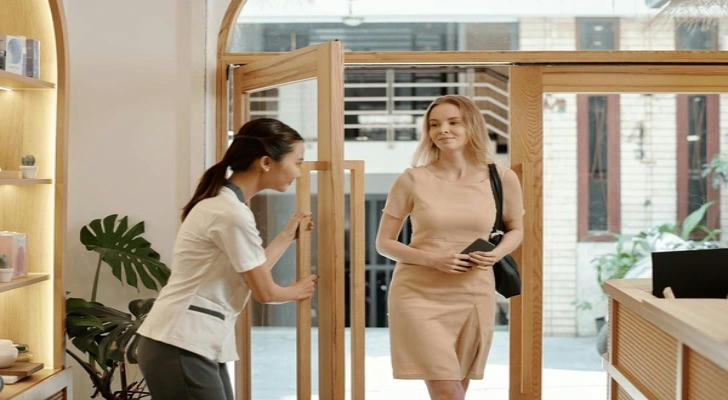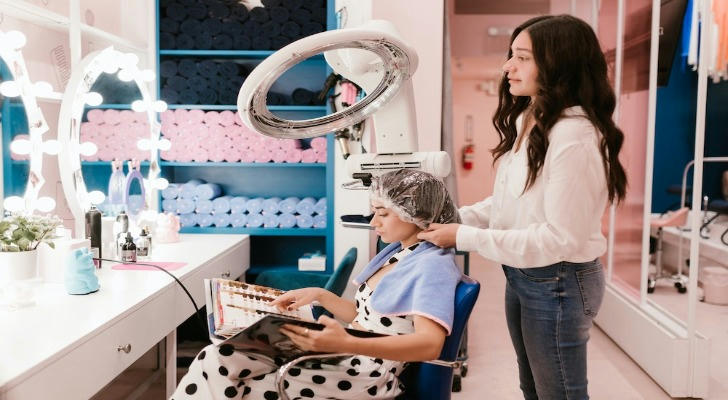Full interpretation of hairdressing service details: Where does customer experience start?
In the modern hairdressing industry, the standard for customers to choose a salon has long surpassed the technology itself. A satisfactory hairdressing experience often starts from the moment you walk into the salon. Every detail in the reception, environment, communication, operation, and service process is a key factor affecting the customer experience.

Ⅰ. First impression: service starting from the door
The customer has not yet sat on the barber chair, and the experience has quietly unfolded. The visual design of the store, the smile of the receptionist, and the cleanliness of the waiting area, these seemingly inadvertent details, constitute the customer's first psychological feeling.
- Environmental layout: soft lighting, comfortable seats, and clean mirrors are all symbols of professional image.
- Welcome and Greeting: A simple "Welcome" or remembering the name of an old customer can make people feel respected.
- Appointment and Confirmation Process: Including whether to confirm the time in advance, start work on time, and inform the estimated service time, etc., are all ways to enhance trust.
The first impression not only affects the overall satisfaction of customers, but also determines whether they will come again.
Ⅱ. In-depth communication: The art of dialogue behind styling
After sitting in the barber chair, what customers look forward to most is often not a haircut immediately, but "communication" with you. At this stage, the professionalism and interpersonal communication skills of the hairdresser directly determine the final results.
1. Understand the real needs of customers
Some customers will bring photos, while others say "a shorter cut is better". Hairdressers need to understand their lifestyle, professional background, daily grooming habits and other information through detailed questions.
Sample questions include:
- "Do you have time to take care of your hair?"
- "Do you mind showing your forehead?"
- "Are there any colors or lengths that you cannot accept?"
2. Guide customers to make choices
Not all customers can clearly express their preferences, which requires hairdressers to give professional advice based on factors such as face shape, hair volume, and hair quality, and show past cases or style reference pictures to help customers make decisions.
3. Build trust
Be sincere, patient, and express yourself clearly, especially when explaining hairstyle restrictions or dyeing and perming effects, do not exaggerate. Establishing real expectations will help reduce misunderstandings and enhance trust.

Ⅲ. Service in progress: integration of technology and details
From shampooing to hair cutting, dyeing and perming, and styling, every step requires the standardization of processes and the execution of details.
1. Washing and care process
Don't underestimate the shampooing process, it is often the most direct "comfortable moment" in the customer experience. Whether the water temperature is appropriate, whether the scalp is gently massaged, and whether the towel is clean and soft, will make customers feel the professionalism of the salon.
2. Haircutting and styling process
Professional use of tools: Clean and neat scissors, hair dryers, and combs are the basis.
Proper explanation of the process: Let customers understand each step of the operation to avoid tension or misunderstanding.
Standing posture and technique: Whether it is flexible and comfortable, whether to pay attention to the customer's sitting posture and expression, also reflects the professional level.
3. Control of dyeing and perming details
The coloring technique when dyeing hair, the time control when perming in different areas, the order of using conditioner, and the care suggestions after styling all show the depth of the hairdresser's skills.
IV. Finished product presentation: How to impress customers with hairdressing results
The moment when the styling is completed is the highlight of the entire service process. The presentation method itself is also extremely important:
- Mirror display and introduction: Let customers view the hairstyle from multiple angles, and introduce the key points of operation or maintenance methods.
- Suggest daily grooming methods: For example, what styling products to use, how often you need to trim, etc., to show your professionalism and thoughtfulness.
- Photo recording: Take photos and keep them with the customer's consent, which is not only convenient for the customer to communicate next time, but also helps you accumulate a portfolio.
Your professional performance at this moment may determine whether the customer is willing to patronize again or recommend friends.

Ⅴ. Service extension after the end
Service should not stop at the moment when the scissors are put down.
1. After-sales care
Actively ask customers about their experience after a few days
Provide follow-up appointment reminders or holiday greetings
Establish WeChat, SMS or social media contact channels
These actions will make customers feel that they are "not forgotten consumers", but friends who are paid attention to for a long time.
2. Encourage feedback and evaluation
A satisfied customer may not only become a repeat customer, but also a recommender of your next new customer. Actively guiding customers to leave reviews can help you optimize your services and increase visibility on local platforms or search engines.
VI. Case story: Kayla's salon experience
Kayla is a freelance writer living in Brooklyn, New York. Her daily work is flexible but busy. She has always hoped to find a salon where she can "relax at ease".
The first time she walked into a nearby salon, she felt a different experience-
"They remembered my appointment time and prepared unsweetened tea. I told the hairdresser that I hate using styling spray, and he immediately designed a natural curly style for me without styling products." Kayla said.
What she liked most was a small card handed over by the other party at the end, which marked the maintenance suggestions of the hairstyle and the best time for the next trim. This made her feel that she was not a "cut and done" customer, but an individual who was served seriously.
Now Kayla goes back every two months and has recommended three friends to become regular customers.
VII. Conclusion
Hairdressing is not only a technology, but also a service art about "experience". Every link from entering the door to leaving hides the opportunity to win the trust and love of customers.
When you put the needs and feelings of your customers first and manage every detail carefully, word of mouth and popularity will naturally follow. In this era that focuses on experience and word of mouth, what really touches people's hearts is not just the scissors and dye, but the "professionalism, sincerity and warmth" you put into every customer.
